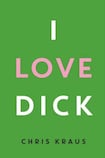
'The situation is now so globally embarrassing there's no choice but to phone Dick to alert him of the fax," writes the narrator of Chris Kraus's I Love Dick. The fax is her accidental transmission of a petition for sex to Dick's work fax machine. The "situation" is the unusual extent to which she's gone up the telegraph pole of infatuation.
Originally published in North America in 1997, I Love Dick was not available from a British publisher until now. Tuskar Rock has created a very handsome green edition, even if they have splattered the inside with unnecessary hyperbole, such as "most important feminist novel of the past two decades". It's not.
I Love Dick was more of a cult hit that was widely read and admired in the visual arts community and celebrated largely outside of the mainstream literary culture. Both are badges of its merit. This edition benefits from an insightful afterword by author Joan Hawkins. It's an important addition that assists the reader because understanding the conceptual frame of Kraus's oeuvre enhances the contemplation and reading of it.
I Love Dick is a wonderful catalogue of contradiction and desire, which benefits from the flexible and imaginative excess of its starting point: infatuation. It's also extremely funny and frantically absorbing.
Chris, a film-maker with a failing film, and her husband, Sylvère, an academic with a plastic hip, are in a fraying, lust-less marriage and packing up their house in California.
Chris has a crush on Dick, an academic colleague of Sylvère’s. Together, through a non-stop barrage of letters to Dick, they record, explore and explode this crush onto the page and onto the unfortunate Dick.
Dick is afforded the right of reply but rarely takes it, meaning the reader instead gets to joyfully intuit Dick’s bafflement.
That all three characters bear a startling resemblance to Kraus, her former husband Sylvère Lotringer and the cultural critic Dick Hebdige has not gone unremarked upon. Is it fiction? Do we care? Not especially, since as Hawkins rightly pegs it, Kraus’s work is “theoretical fiction” or as Lotringer describes it “something between cultural criticism and fiction”.
The novel is told through a mostly epistolary form, which bends into a journal and “Dear Dick” becomes “Dear Diary”. Dear Diary then very literally records dear Dick. At one point, Chris and Sylvère assume the personas of Charles and Emma Bovary in their desperate dispatches.
The Dick device is very clever because it allows departures or tangential submissions on film, literature, critical theory, on the disappointment inherent in a life in visual arts, the frustrations of the academy, a compiling/unearthing of the creative process, her shame, her pleasure in misbehaviour and the angst-filled fade that is middle age.
The unmet, unrequited, silently rebuked sexual infatuation becomes the wall of despair against which Chris’s accumulated disappointments, rejection and grief can be bounced and rebounded to become plus-sized agony. Dick is the perfect repository for the misery that is loving Dick and the misery that is living life while you love Dick and even before you loved Dick.
Dick not only doesn’t love you, he barely acknowledges you. Yet Dick has become the whole Monopoly board. Just as art monopolises artists, it too can be very much like Dick and fuel limitless gloom.
Sylvère eggs Chris on. Chris despairs. Chris writes another letter to Dick. Dick does not reply. Sylvère, our epistolary cuckold, weighs in on “their” next step. Sylvère writes a letter to Dick. Chris writes a letter to Dick contradicting what Sylvère has just written. Sylvère is as invested in Chris bedding Dick because Dick is it. Dick is all. Dick is now their entire life.
Dick has now produced an art project of 88 pages of single-spaced text. Dick doesn’t want either of them nor the art project.
Somehow in there, we learn retroactively, Chris does sexually summit Dick once. In rather a detached, unerotic “neutrality” Dick ponders her proposal in his living room with about as much enthusiasm as buying a pair of socks. He is clearly terrified and suspicious of overt female desire.
Afterwards, in bed together, Chris describes him as “militantly callous” while Dick maintains she doesn’t know him, has projected “this shit all over me” and he thinks she’s “evil and psychotic”.
But the completion of the act, however unerotic, offers Chris a parallel tract of solo letters to Dick. These coincide with her meandering across various American cities.
There's a strong hint of cinematic works such as Patrick Keiller's London in the narrator as guide and witness here. The work of the Situationists comes to mind. Except the journey here is not in physical geography; rather it's a wander into the imaginary wasteland of unfulfilled desire. "Why don't you want me, Dick?" is the M25 and ring road inside this novel.
Ultimately the deconstruction of loving Dick delivers Chris the keynote that art culture has denied her. It confirms “. . . there is something inherently grotesque, unspeakable, about femaleness, desire” and provides the materials for “Who gets to speak and why?” with a permanent installation.
Anakana Schofield's new novel is Martin John








